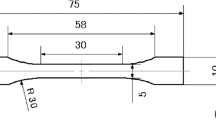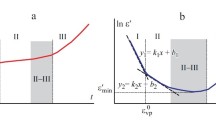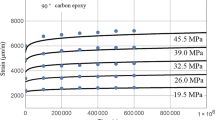Abstract
In many applications it is useful to be able to convert observed creep data of a material to corresponding stress relaxation data or vice versa. If the material exhibits non-linear viscoelasticity such a conversion can be rather difficult. In this paper two semi-empirical flow equations, the power law and the exponential law, are used to convert stress relaxation data into corresponding creep behaviour data. These two flow equations are often used to describe non-linear viscoelastic behaviour. The procedure adopted here is based on the assumption that the creep data during the experiment decrease due to an increase in the internal stress level, thus decreasing the effective stress for flow. The conversion method is applied to high density polyethylene and polycrystalline molybdenum at room temperature. In general predictions using the power law are in better agreement with the experimental results than predictions using the exponential formula. The concepts of secondary and ceasing creep are discussed in terms of build-up of internal stress during the creep process.
Similar content being viewed by others
References
Ferry JD (1980) Viscoelastic Properties of Polymers, 3rd ed. John Wiley & Sons Inc, New York
Ward IM (1983) Mechanical Properties of Solid Polymers, 2nd ed. Wiley-Interscience, London
Findley WN, Lai JS, Onoran K (1976) Creep and Relaxation of Nonlinear Viscoelastic Materials. North-Holland Publ Co, New York, p 240
Krausz AS, Eyring H (1975) Deformation Kinetics. Wiley-Interscience, New York
Garofalo F (1965) Fundamentals of Creep and Creep Rupture. MacMillan, New York
Gittus J (1975) Creep, Viscoelasticity and Creep Fracture in Solids. Appl Sci Publ Ltd, London
Becker GW (1959) Kolloid-Z 166:4
Brüller OS, Pütz O, Klein V (1976) Rheol Acta 15:533
Wu LM, Meinecke EA, Tai BC (1978) Rubber Chem Techn 51:117
Tanaka C (1976) Trans Nat Res Inst Metals 18:14
Tanaka C, Ohba T, Kori M (1978) Trans ISIJ 18:412
Hammamy AK, Dubofsky W, Stüwe HP (1977) Z. Metallkde 68:417
Feltham P (1961) Phil Mag 6:259
Pollock JTA, Barton SG, Clissold RC (1981) Mater Sci Eng 49:155
Wilding MA, Ward IM (1984) J Mater Sci 19:629
Högfors C (1984) Rheol Acta 23:322
Li JCM (1967) Can J Phys 45:493
Kubát J, Rigdahl M, Seldén R (1976) J Appl Polym Sci 20:2799
Derby B, Ashby MF (1984) Scripta Metallurgica 18:1079
Hagström B (to be published)
Kubát J (1965) Nature 204:378
Kubát J, Seldén R, Rigdahl M (1978) Mater Sci Eng 34:67
Kubát J (1963) Ark Fys (Sweden) 25:285
Kubát J, Seldén R, Rigdahl M (1978) J Appl Polym Sci 22:1715
Gupta I, Li JCM (1970) Metallurgical Trans 1:2323
Kubát J, Rigdahl M, Seldén R (1978) Phys Stat Sol (a) 50:117
Högfors C, Kubát J, Rigdahl M (1981) Phys Stat Sol (b) 107:147
Kubát J (1982) Phys Stat Sol (b) 111:599
Author information
Authors and Affiliations
Rights and permissions
About this article
Cite this article
Ek, C.G., Hagström, B., Kubát, J. et al. Prediction of the creep behaviour of polyethylene and molybdenum from stress relaxation experiments. Rheol Acta 25, 534–541 (1986). https://doi.org/10.1007/BF01774405
Received:
Issue Date:
DOI: https://doi.org/10.1007/BF01774405




